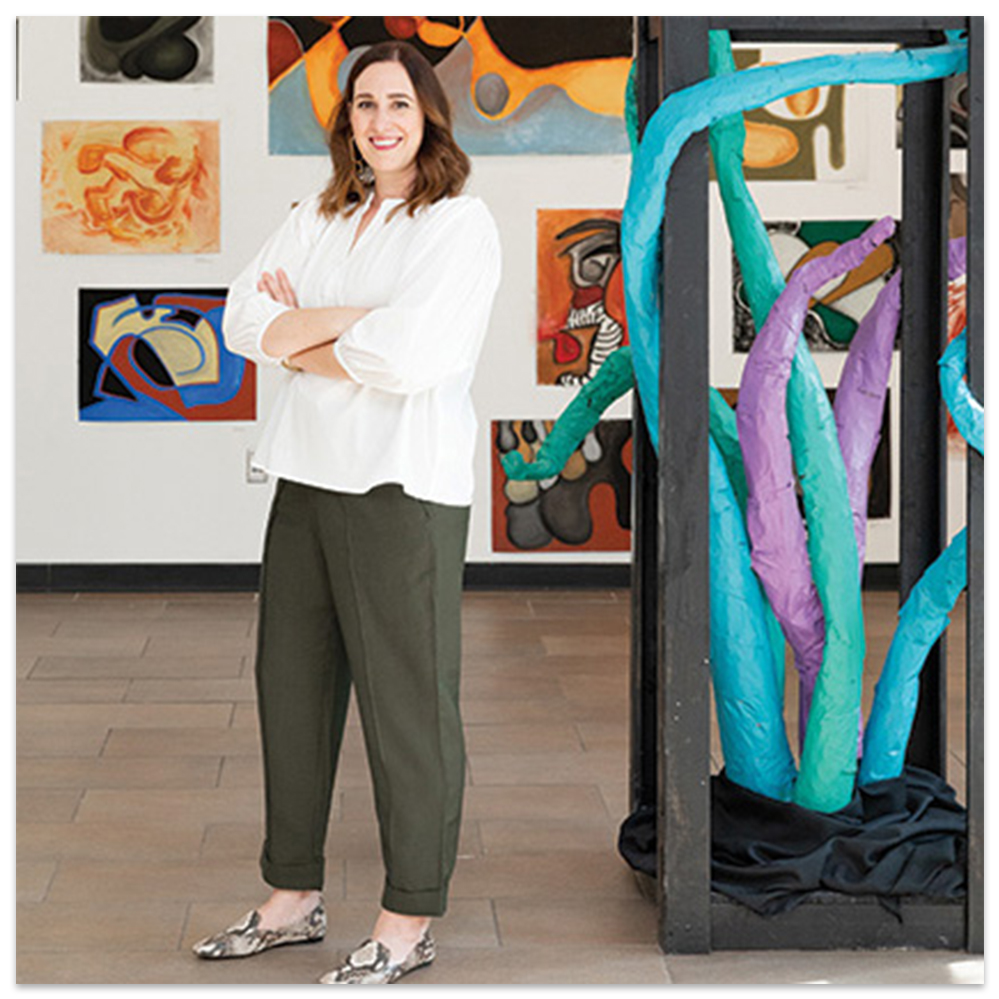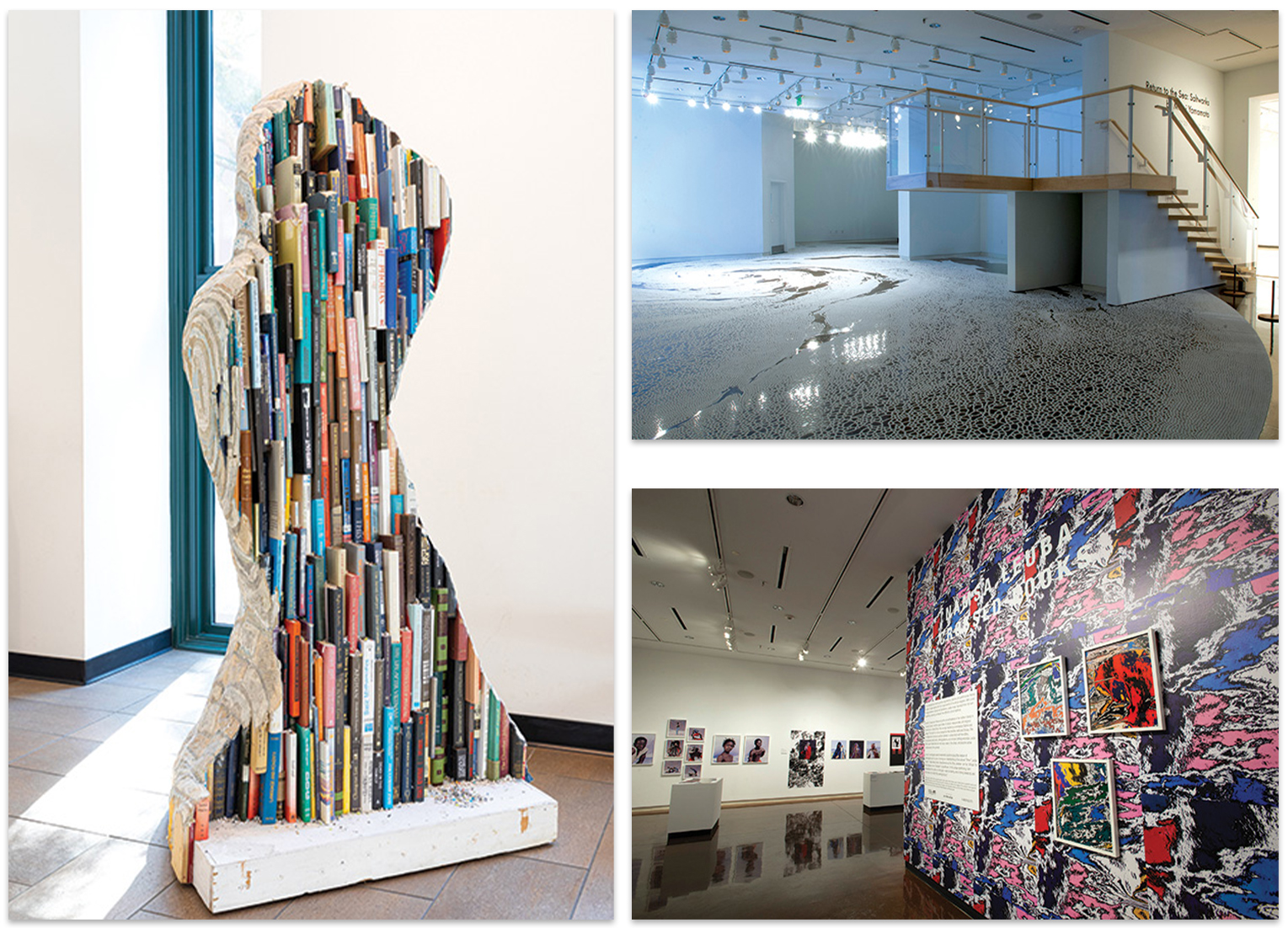
Katie Hirsh in the Hill Gallery, just outside the Halsey’s doors, where works by the Studio Art program’s senior thesis class are on display.
WRITTEN BY Stephanie Hunt
PHOTOGRAPHS BY (portrait) Aleece Sophia & (5) courtesy of Halsey Institute of Contemporary Art
Among the many hidden gems in Charleston—the obscure alleyways, the secret gardens, the waterfront breezes at the tucked-away Irish monument—there’s a tiny cinema in a back corner of the Halsey Institute of Contemporary Art at the College of Charleston, where videos revealing artistic genius run on continuous loop. It’s a fabulous oasis, and like the Halsey itself, a haven of inspiration—just one aspect of the Holy City’s premier contemporary art gallery that is now Katie Hirsch’s creative playground. As the new director and chief curator of the Halsey, Hirsch not only gets to be a teeny movie-house director but also set the tone for all things edgy, quirky, and provocative for the city’s art scene.
It’s a tall order for this Fincastle, Virginia, native who grew up sans “any significant exposure to art in my hometown,” says Hirsch. On trips with her family, however, she always loved exploring museums—“these big places that gathered up lots of stuff.” She dreamed of becoming an archaeologist, until registering for an art history class at Virginia Commonwealth University. “I had no idea what art history was but soon realized, ‘Wow, I could study these objects after they’ve been removed from the ground.’”
She went on to pursue graduate studies focused on pre-Columbian Mesoamerican ceramics—specifically funeral urns. Her interest wasn’t morbid, rather she was captivated by the story of lives lived. “This fascinating intersection of form and function, the way the urns and the funerary visual culture was this perfect nexus of what was important to a person and a culture at a certain period. I’m interested in the idea of sacred and powerful objects,” Hirsch says. “And now I’m focusing that on the work of contemporary visual artists. But it’s really all the same thing—people trying to express what’s important to them.”
Midway through a PhD program, Hirsch took a break and moved to Shanghai to teach English. “I planned on staying for six months, which turned into two years. It changed my life’s trajectory,” says Hirsch, who loved Shanghai’s mix of cultures from around the world. There, she met her now-husband, Jonathan, a maritime attorney, and worked in a gallery after teaching. The couple returned stateside in 2015, moving to Charleston “totally on spec.” Hirsch initially worked in the development and events office at Spoleto—“being introduced to Charleston through the festival’s eye was great,” says Hirsch, whose own eye was soon drawn to the Halsey, where she encountered a 2015 exhibit by Korean-born artist Jiha Moon. “Coming from Shanghai, I loved the clever East-meets-West mash-up. I realized that any place interested in amplifying [Moon’s] voice was the place for me. I saw that they were asking really interesting questions here,” says Hirsch. She went to the founding director, Mark Sloan: “Please tell me how I can work here,” she asked, “because I’m going to.”

Works previously on display at the Halsey by (clockwise from left) former artist-in-residence Jiha Moon, Motoi Yamamoto (2012), and Namsa Leuba (2021)
After working alongside Sloan for five years, eventually becoming a curator and the director of strategic partnerships, Hirsch—the mother of a toddler and an infant (“I came to work with spit-up on my blazer this morning”)—officially stepped into her mentor and friend’s large shoes in April 2021, after a few months as interim director. She’s inheriting a healthy institution, and one she knows well. “I feel so lucky to bring my own vision to build on the strengths already there,” says Hirsch. That vision includes continuing to diversify the voices represented, “including the voices that bring the voices,” she says, i.e. inviting guest curators from other institutions and collaborating with local arts organizations.
“I love that there’s no admission fee, so people can pop in for seven minutes or stay for two hours... I want the Halsey to be a part of your world.” —Katie Hirsch

Halsey Hallmarks: (Left to right) Hirsch began her tenure by presenting the work of Dyani White Hawk “HEAR HER” (winter 2022) and will continue to push the edge in Halsey style, as with past shows such as Nick Cave (2010)
By joining forces with peer institutions such as the Colorado Springs Fine Arts Center at Colorado College and the Southwest School of Art in San Antonio—as the Halsey is doing this year to produce an exhibit by Peruvian-American artist Kukuli Velarde (the show opens May 13)—Hirsch is stretching the norms of what the institution can undertake on its own. She’s energized by the college vibe and celebrates the Halsey’s unique position “with one foot on campus and one in the outside world. I love that there’s no admission fee, so people can pop in for seven minutes or stay for two hours; they can freely move in and out of the galleries,” says Hirsch. “I want the Halsey to be a part of your world.”
Exhibit Notes
Excited About: “Shows by Kukuli Velarde and Nancy Friedemann-Sánchez—two powerhouse artists reflecting on the legacy of colonialism”
Challenges Ahead: “Building back habits along with our community as we adapt post-pandemic”